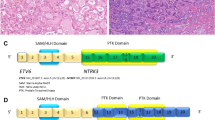Abstract
Our knowlcwdge about the genetic basis of head and neck tumours is accumulating fast. This article reviews the important advances in this area over the last decade and its implications for the future. Newer aspects of gene therapy, molecular staging and understanding head and neck carcinogenesis on a molecular level are outlined.
Similar content being viewed by others
References
Renan M J, (1993): How many mutations are required for tumorigenesis ? Implications from human cancer data. Mol Carcinogenesis 7: 139–146
Pardee A B (1989): G1 events and regulation of cell proliferation. Science, 246: 603–608.
Sidransky D, Brennan J A et al: (1995) Molecular assessment of histopathologic staging in Head and Neck Squamous Cell Carcinoma. Current Opinion in Otolaryngology-Head and Neck Surgery, vol. 332, no. 7, pp 429–434.
Dolcetti R, Doglino C, et al (1993) p53 is an early event in the development of human Squamous cell carcinoma of the larynx: genetic and prognostic implications. Int J Cancer, 52: 178–182.
Pruneri C, Pignatoro L et al (1994) p53 protein expression in laryngeal squamous cell carci-noma bearing wild-type and mutated p53 gene. Histopathology 28: 513–519.
Jares P, Fernandez P L et al (1994) PRAD-1/Cyclin D1 gene amplification correletes with tumour progression in human laryngeal carcinomas. Cancer Res., 54: 4813–17.
Callendu J, el-Nagger AG, Li M S et al (1994) PRAD-1/Cyclin D1 oncogene amplification in primary HNSCC. Cancer, 74: 152–8.
Sidransky D: Molecular genetics of head and neck cancer (1995). Current Opinion in Oncology; 1995, 7:229–233.
Speicher MK, Howe C et al (1995) Comparative genomic hybridization detects novel dele-tions and amplifications in HNSCC. Cancer Research; Marl,55(5):1010–3.
Scott-Brown’s Otolaryngology vol. 1: Cell Biology; Wilson S Mertens, 1/20/6 pp.6
Field JK (1992); Oncogenes in Tumour Suppressor Genes in squamous cell carcinoma in the head and neck. Oral Oncology, European J of Cancer, 28B, 67–76.
Eversole L R, Sapp JP (1993); Oncogenes and tumour suppressor genes in squamous cell carcinoma of the head and neck; Oral Oncology, European J of Cancer.
Clarke Louis J (1996); Clinical Genetics of Head and Neck Cancer; CME Bulletin, Otorhinolaryng-ology, vol 1: no. 1, Oct, pp 12–15.
Grandis JR, Tweardy D J (1998); Elevated levels of TGF-a and EFGR m-RNA are early mark-ers of carcinomma in HNSCC. Cancer Res; 53: 3579–84.
Grandis JR, Melhem MF et al (1998); Levels of TGF-a and EFGR protein in HNSCC and patient survival. J Natl Cancer Institute; 90(11): 824–32.
Nin F (1998); Immunohistological studies on growth potential of head and neck carcinomas] Nippon Jibiinkoka Gakkai Kaiho; 101(3):312–326.
Hoffman T, Hafner D et al(1997); Anti-tumour activity of EFGR antibodies and cispktin in 10 human HNSCC lines. Anticancer Res; 17(6D): 4419–4425.
Gasparotto D, Maestro R et al: Overexpression of CDC 25 A CDC 25 B in head and neck cancers. Cancer Research 57 (12):2366–8.
Oliner JD, Pietenpol J A et al : Oncoprotein MDM-2 conceals the activation domain of tumour suppressor p53. Nature : 362: 857.
Pignataro L, Cappacio P et al: The predictive value ofp53, MDM-2, cyclin D1 and Ki-67 in the progression of low-grade dysplasia towards carcinoma of larynx. JLO, vol. 112, pp. 455–459.
Hollstein M, Sidransky D et al (1991): p53 mutations in human cancer. Science: 253: 49–53.
Whistler L C, Wood N B et al(1998); Regulators of proliferation and apoptosis in carcinoma of larynx. 630–638.
Kernohan NM, Cor L S(1996); Regulation ofapoptsis by bcl-2 and related proteins: immuno- logical challenges and therapeutic applications. J of pathology, 179 :1–3.
Ahomadegbe JC, Barrois M et al(1995); High incidence of p53 alterations in Head and Neck primary tumours and metastases; frequent protein overexpression in normal epithelium and in early non-invasive lesions. Oncogene: 10: 1217–27.
Bradford C R, Zhu S et al(1997); p53 mutations in advanced laryngeal cancer. Archives of Otol. H & N Surgery. 123(6): 605–9.
Gonzalez M V, Pello M F et al (1997); Deletion and methylation of tumour suppressor genes in primary HNSCC. J Clin Pathol 50(6)509–512.
Narayana A, Vaughan AT et al(1998); Is p53 an independent prognostic factor in patients with laryngeal carcinoma ? Cancer: 80(2) :286–91.
Nogueira CP, Dolan RW et al(1998); Inactivation of p53 and amplification of cyclin D1 correlate with clinical outcome in head and neck cancers. Laryngoscope 108 (3):345–50.
Couturier J, Sartre-Garan X et al: Integration of papilloma virus DNA near myc genes in genital carcinoma and its consquences for proto-oncogene expression. 1991 :J of Virology, 65, 4534–38.
Mackaig RG, Baric RS, Olshan AF (1998); HPV and Head and Neck cancer: Epidemiology and molecular biology, 1998; Head-Neck, 20(3):250–265.
Frixen U, Behrens J et al(1991); E-cadherin-mediated cell-cell adhesion prevents invasiveness of human carcinoma cell. J of Cell Biology; 113, 173–185.
MacDonald NJ et al(1993); A novel phosphorylation of nm23, not its NDPK activity corre-lates with metastatic potential; Proceedings of the American Association of Cancer Re-search; 1993:34,A393.
Chambers A F, Tuck A B(1993); Ras-responsive genes and tumour metastasis. Critical Re-views in Oncogenesis 4, 95–114.
Rak J, Filmus J et al(1995); Oncogenes as inducers of tumour angiogenesis. [Review] [85 references. Cancer and Metastasis Reviews. 14(4): 263–77
Gallo O, Masini E et al: Role of nitric oxide in angiogenesis and tumour progression, 1998 April: I Natl Cancer Institute; 90(8): 587–96.
Boyle JB, Mao L et al (1994); Gene mutations in saliva a molecular markers HNSCC. Am J Surgery: 168:429–432.
dayman GL, el-Naggar AL et al : Adenovirus-mediated p53 gene transfer in patients with advanced HNSCC. J Clin Oncol; 16(6):222–2232.
Author information
Authors and Affiliations
Rights and permissions
About this article
Cite this article
Bhattacharyya, A.K., Ghosh, S. Recent advances in the molecular biology of head and neck tumours. Indian J Otolaryngol Head Neck Surg 51, 10–18 (1999). https://doi.org/10.1007/BF03022707
Issue Date:
DOI: https://doi.org/10.1007/BF03022707




